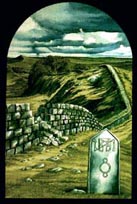 |
|
|
 |
|
|
|
THE BASIS OF
THE CELTS BELIEFS THE APPEARANCE
OF CHRISTIANITY THE INTEGRATION
OF CELT AND CHRISTIAN THE DEITIES THE RULE OF
THREE The most obvious change to the concept of Trinity from Celt to Christian was the strong slant towards female rule, which was moved very definitely to the male. Until this point, this was unheard of in Celtic society. Before Christianity entered the British Celtic Isles, women had held equal, and in some instances higher, status than men in matters of inheritance, law and spirituality. |
|
May Mary shield me, May Michael shield me, On sea and on land: To shield me from all anguish On sea and on land, To shield me from all anguish. May Father aid me, May Son aid me, May Spirit aid me, On sea and on land: In the shielding of the City everlasting On sea and on land, In the shielding of the City everlasting. May the Three succour me, May the Three follow me, May the Three guide me, On sea and on land, To the Vine-garden of the godlike On sea and on land, To the Vine-garden of the godlike. |
|
In this section you will find a breakdown of the Celtic Festivals and a brief outline of the first Christian monastary founded on the Isle of Iona by St. Columba. |
|
|
| You will find credits and links to the generous souls who have provided the Celtic art, music, poetry and reference material free on the Web, as well as a bibliography of the books and publications that make up a large part of my library and have been a rich resource for these pages in the Credits list. |
|
| outer
hearth | anteroom | high court | ceridwen's well | forest of rites | | inner hearth | ealasaid's realm | trophy room | eternal circles | portal | | the book of dreams | the messenger | |